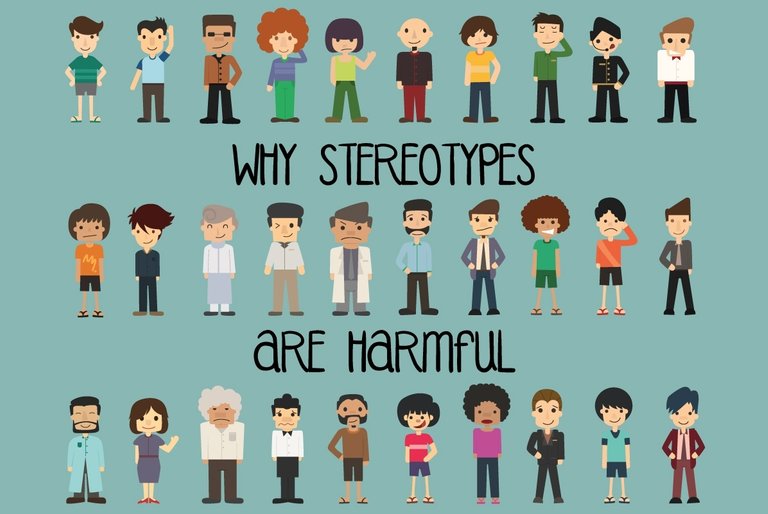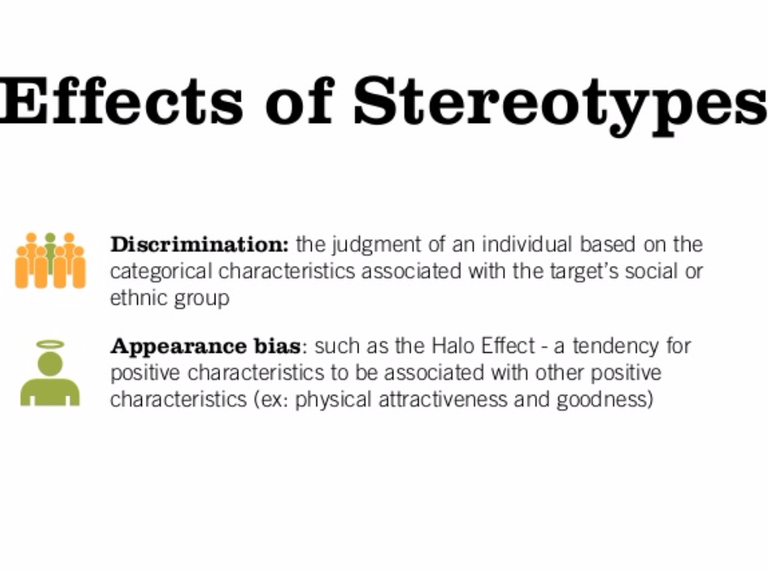As mentioned in my previous post I studied A-level psychology in UK as a part of my access course. I ended up writing an essay about stereotyping for my written exam, which is exactly what you’ll find just down below. It seemed appropriate to post, as it complements my other post about labeling , but here, presented from an academic perspective. On that note, then I do believe that the content in its entirety are correct, although, don’t take my word for it, as I never did end up studying psychology at University.
Social Psychology: The Features of Stereotyping
According to general knowledge, stereotyping is best known as a descriptive guide which helps humans to process information about other people. This can based upon one or more shared traits; for example, age, ethnicity or profession. Before reading this sentence, you probably assumed that this content would be reliable. But, as we know, general knowledge, whether it is word of mouth or Wikipedia are not a so-called trusted source. Although stereotypes and general knowledge often holds fragments of truth, but they are simultaneously flawed and/or inaccurate.
Stereotyping in context of social psychology, is a cognitive automatic process which uses a role schema to categorize someone, based on primers received (Hewston et al, 2012). In other words, the automatic process is a shortcut for the brain to simplify and encode surroundings. Hence why, people who share collective traits are being categorized in the first place. While, primers (e.g. link, mental navigation) are used to activate a schema, who retrieves predigested information, to identify expectancies or definitions of an object or an individual. When that information becomes established it is called a heuristic, meaning incontrovertible truth (Hinton, 2000). In the 1970’s it was questioned whether stereotyping was the result of ‘faulty’ thinking opposed to ‘correct’ thinking (e.g. Tajfel,1969; Hamilton,1979). It was later put forward that it ought to be regarded as ‘ordinary’ cognition, building on ideas of Lippmann(1922) and Allport(1954). Humans need to simplify and categorize the social world, therefore, these are not mental failings, but features of the way human cognition operates (Hinton, 2000).
Stereotyping can be helpful, as it simplifies the procedure used to encode situations and surroundings. However, it is also a consequence of humans limited cognitive ability to holistically operate (Hinton,2000). Hinton (2000) argues that it ignores the individual characteristics within a group, and is therefore not reliable. Moreover, the general knowledge which has helped shape this image might be biased. Moscovici’s (1984) social representations theory explains the creation of everyday knowledge and how it eventually leads to consensus. Moscovici(1998) uses the analogy of money to convey the idea of how social representations are developed: Just like currency, it can be illustrated in various forms, but the characteristics which sculpt the consensus of value, are similar to how humans communicate representative ideas. According to Moscovici (1973), the ‘social representations are cognitive systems’, hence why he further argues that social cognition research lacks the collective and dynamic aspects which follows. Augoustinos & Innes research (1990;1995), considers social knowledge to be static in the schemas, as once implemented it ought to be resistant to change. Conversely, Moscovici argues that social representations are ‘fluid’ and will continuously redefine themselves and be negotiated through interaction and communication (Augoustinos and Walker, 1995). A further criticism of the cognitive approach is that it tends to ignore the role of culture (Hinton, 2000).
D’Andrade (1990) defines a cultural model as ‘a cognitive schema that is intersubjectively shared by a social group’. He compares the cultural schema through a ‘restaurant script’; Although the components (entering, ordering, eating and leaving) remain the same, the script will be inconsistent within the different cultures. For example in a British restaurant, everyone would be given a menu to decide from. While in Brazil, only the host would have a menu as he can recommend dishes for his guests (Smith and Bond, 1998). The various ‘scripts’ suggests that social representations are drawn much more from a situational and cultural stand, opposed to an established communicative consensus. Which is why Flick (1998) stresses that the components used to construct a social representation are much more dynamic than first anticipated. Even if we regard the components and the process as fluid, such as Moscovici proposed, it is still very hard to change or disprove the ideas which materialize from general knowledge.
Hinton (2000) states that by presenting a counter-evidence regarding a stereotype, will not necessarily lead to that view being abandoned. Instead, the evidence are viewed as an ‘exceptional case’, which serves to reinforce the initial stereotypical view, rather than it being debunked. The appropriate terminology an ‘exceptional case’ in this context is called subtyping, which is also where stereotyping can become problematic: the assumption that the stereotypical characteristics attributes to a group of people are inherent to the members of the group (Brown, 1965; Campbell, 1967).
Stereotyping can particularly become biased when it is formed of primers with negative connotations, such as a misconception, or a judgement (prejudice). This can result in the targeted social groups to become more susceptible to discrimination (Hinton, 2000). For example, “black people are more inclined to commit crime”. Firstly, there is a subliminal message suggesting white (and other) people do not commit (as much) crime, which contributes to further scapegoating of black people. Secondly, most black people are law abiding citizens, which raises the question about why this misconception is presented the way it is. It is also in this context the relationship between stereotyping and prejudices are revealed. Although, there are evidence of positively presented stereotypes, such as the French who are viewed as romantic and cultured.
When it comes to stereotypes most people will mimic their behavior in relation to a social attitude ever so often. For example, in a situational professional setting, people might dress or talk differently to be more consistent with the expectancies drawn from a related stereotype. Turner(1987) refer to this as self-categorization theory. It focuses on the groups which the individual consider themselves a member, and concerns the person’s definition of self-concept. Hereinafter, there will be a tendency for the person to perceive themselves in terms of the groups which they belong (Hinton, 2000, p.119). Turner refers to this as depersonalization, but it can also be seen as ‘self-stereotyping’. Another example would be ‘punkers’ in the 1970’s who defined themselves through their external ‘stereotype’ to promote political ideas.
As a conclusion, social schemas are used to categorize people, which can lead to stereotyping. Stereotyping is believed to transpire due to the limited human cognitive function, and is essentially a key-worded, cognitive shortcut which helps humans to operate and interpret surroundings better. The combination of base rate information and the circulation of a shared consensus within social groups is what transfers the topic to become general knowledge. These perceptions are hard to debunk, and can be biased due to cultural differences or misconceptions. Additionally, the components can oscillate with time. Thus, it is only in rare events that these statements can be regarded as facts, and one should exert caution to assume that all members of a social group share inherent traits.





Congratulations @nocompassnorway! You have completed the following achievement on the Steem blockchain and have been rewarded with new badge(s) :
Click here to view your Board of Honor
If you no longer want to receive notifications, reply to this comment with the word
STOPDo not miss the last post from @steemitboard: